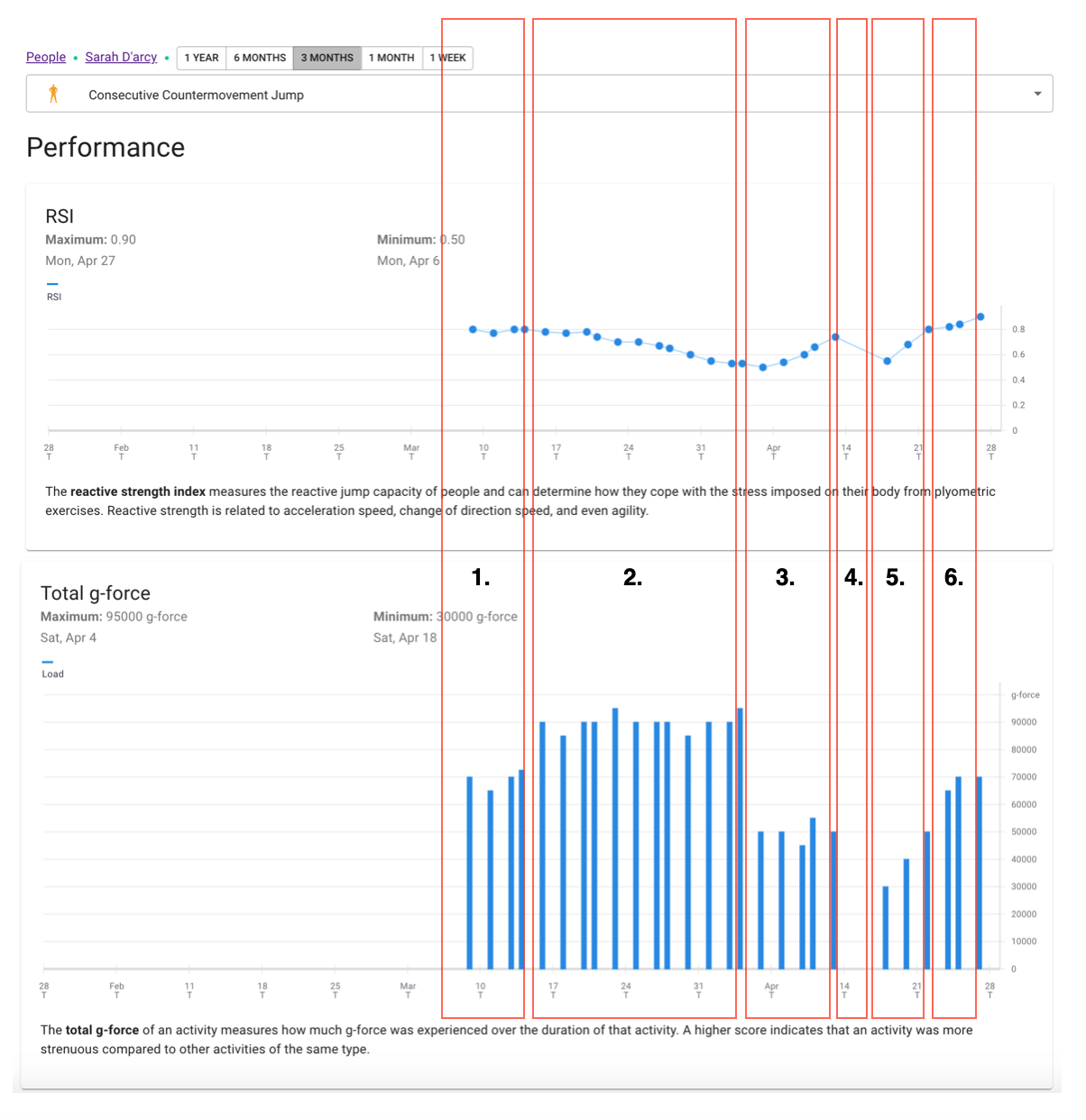Sarah is a 25 year old elite athlete preparing for an international tennis competition. Plantiga insoles were used to track the relationship between Sarah’s practice intensity and her reactive strength index (RSI) throughout her competition-specific training schedule. Shown is seven weeks of training data; the first week represents Sarah’s normal training schedule, and the last six represent Sarah’s competition-specific training schedule.

1. 0-1 weeks leading up to competition (Non-competition-specific training schedule)
- Practice Load - Sarah averages around 70k g-forces each practice during a typical training schedule
- RSI - Sarah averages an RSI of around 0.8 each practice during a typical training schedule
2. 1-4 weeks leading up to competition (Pre-competition Training) - High Intensity, High volume
- Practice Load - To prepare for competition, Sarah’s training sessions are designed such that they maintain high intensity and high volume, averaging about 90k g-forces per practice.
- RSI - Sarah begins this period of high intensity training with an average RSI score of roughly 0.8, but throughout this period of training, her RSI begins to drop significantly in the last week. This drop in RSI demonstrates the neuromuscular fatigue she is experiencing due to the nature of high intensity training.
3. 4-5 weeks leading up to competition (Tapering Period of Pre-Competition Training) - High Intensity, Low Volume
- Practice Load - As a result of the drop in RSI, Sarah’s training shifts to the tapering period, in which Sarah will maintain the intensity of practice, but decreases the volume at which she trains. During this period, she averages around 50k g-forces per practice.
- RSI - Sarah begins this tapering period fatigued with an RSI of around 0.5, but through this tapering period she is able to increase her RSI score back to her average of 0.74.
4. 5.25-5.50 weeks leading up to competition (Travel Period) - No training
- Practice Load - No values
- RSI - No values
5. 5.75-6.25 weeks leading up to competition (Travel Recovery) - Low intensity, low volume training
- Practice Load - After traveling, Sarah is quite fatigued, as shown by her low RSI score of 0.55 (.25 points below her average). So in order to allow her to return to her baseline, Sarah’s training will begin with low intensity and increase slowly until she is able to train hard and show good performance before her competition.
- RSI - Sarah’s RSI score of 0.55 represents her fatigue after travel, but through the slow progression of practice intensity she is able to regain her average RSI of 0.8.
6. 6.25-7 weeks leading up to competition (Final Pre-Competition Training): High Intensity, Low volume
- Practice Load - With an RSI of 0.8, Sarah is fit to begin high intensity training again. She therefore begins a high intensity, low volume training schedule the week before competition to prepare her for competition and help her perform at her maximal abilities.
- RSI - Through this tailored training schedule, Sarah is able to hit a new personal best RSI of 0.9 the day before her competition, representing that she is at the peak of her abilities and is ready to compete.
Summary:
With precise measurement of performance specific metrics, Sarah’s six week training schedule was personalized and adjusted to her body’s natural fatigue patterns, allowing her to rest when needed and train hard when appropriate. She was thus able to record her peak RSI the day before competition, demonstrating her readiness to compete.
.png?height=120&name=Plantiga%20lockup%20black%20(1).png)